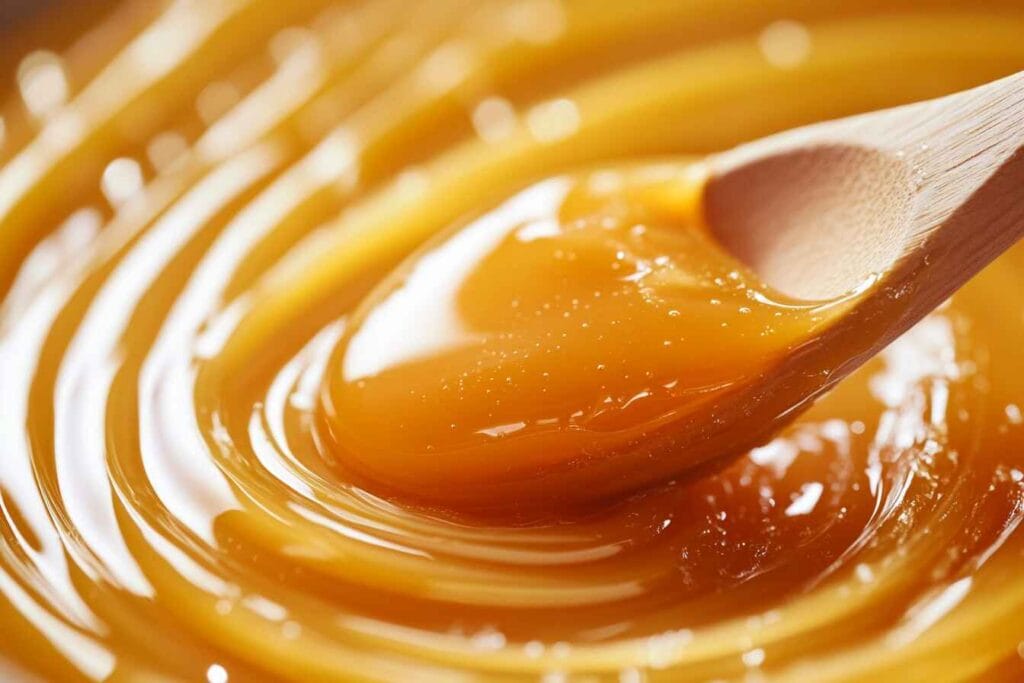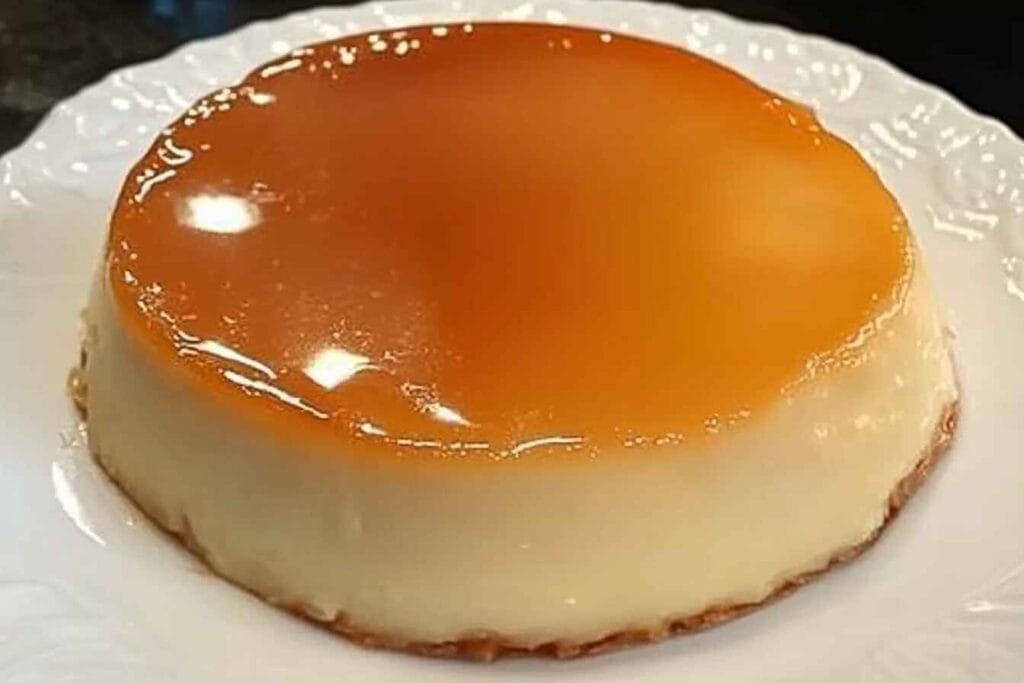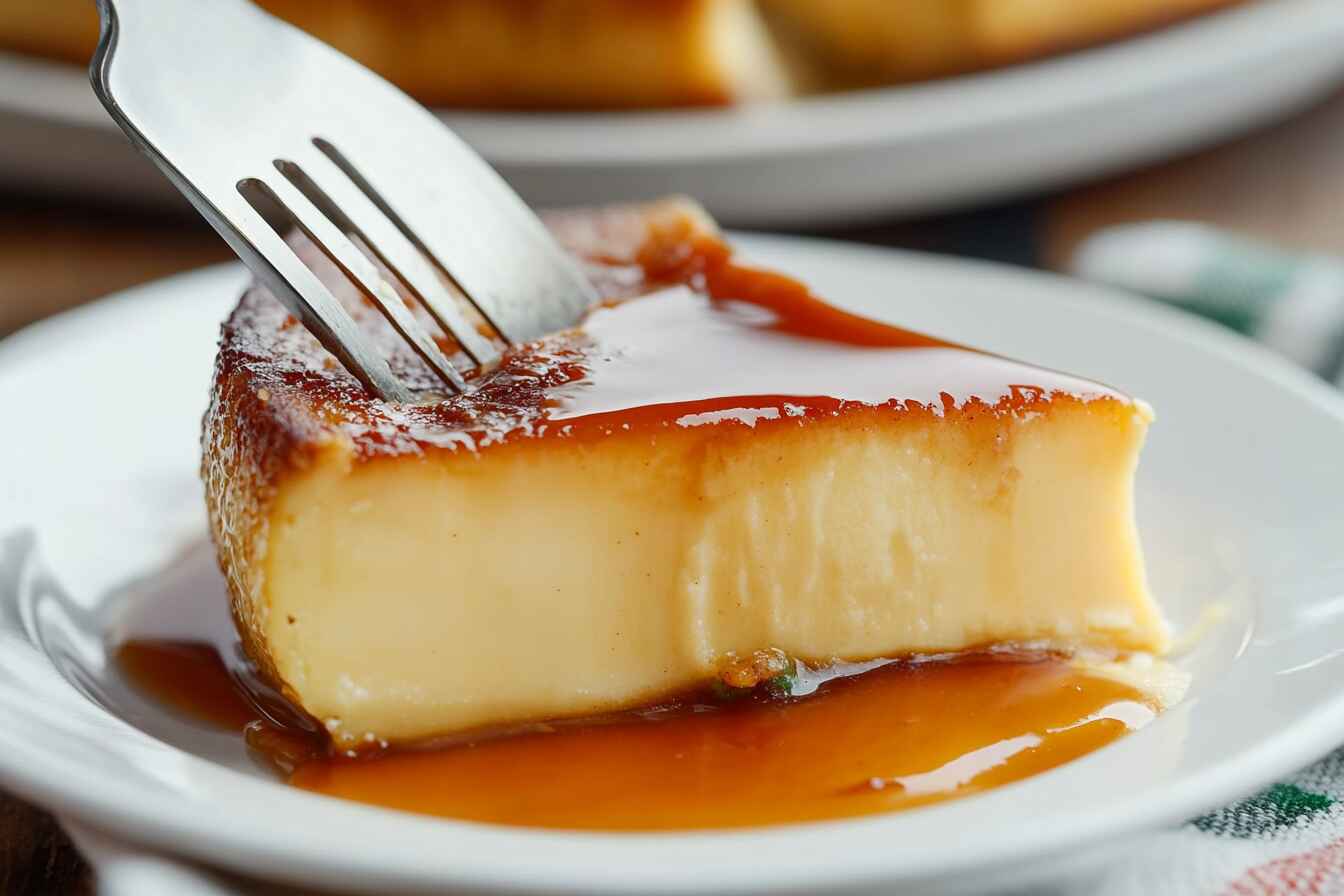Table of Contents
Have you ever taken a bite of a dessert so creamy, so rich, and so smooth that it just melts in your mouth? If you haven’t tried Quesillo yet, you’re missing out on one of the best-kept secrets of Latin American cuisine! This silky caramel custard is a must-try for dessert lovers who appreciate simple ingredients coming together in a magical way.
In this ultimate guide, we’ll explore everything you need to know about Quesillo – from its origins to step-by-step instructions, common mistakes, and expert tips. So, let’s dive in!
What is Quesillo? A Delicious Latin American Delight
Quesillo is a rich caramel custard dessert that originates from Venezuela but is enjoyed across Latin America. It’s often mistaken for flan, but there’s a slight difference – Quesillo is made with whole eggs, giving it a firmer, airy texture with tiny holes, unlike the smooth consistency of traditional flan.
The Origin and History of Quesillo
The origins of Quesillo trace back to Venezuela, where it became a beloved household dessert. The name “Quesillo” means “little cheese,” not because it contains cheese, but because its appearance resembles that of a soft, holey cheese when sliced.
“In Venezuela, Quesillo is the go-to dessert for birthdays, family gatherings, and special occasions. It’s served chilled, often with a drizzle of extra caramel sauce.”
Quesillo vs. Flan: What’s the Difference?
Quesillo and Flan are like cousins – they share similar ingredients but differ in texture and method of preparation.
| Feature | Quesillo | Flan |
|---|---|---|
| Texture | Airy with tiny holes | Silky and smooth |
| Main Ingredient | Whole eggs | Egg yolks or mixed eggs |
| Cooking Method | Steamed or baked in a water bath | Mostly baked |
Both are deliciously caramelized, but if you love a custard with a bit more texture, Quesillo is your best bet!
Ingredients Needed to Make Traditional Quesillo
Making Quesillo at home is surprisingly simple. You only need a handful of ingredients that you probably already have in your kitchen!
Essential Ingredients for the Perfect Quesillo
Here’s what you’ll need:
| Ingredient | Quantity |
|---|---|
| Sugar | 1 cup (for caramel) |
| Eggs | 6 large eggs |
| Sweetened condensed milk | 1 can (14 oz) |
| Whole milk | 1 can (use the same condensed milk can for measurement) |
| Vanilla extract | 1 teaspoon |
| Rum (optional) | 1 tablespoon |
Alternative Ingredients for Dairy-Free and Vegan Options
Want to make a dairy-free or vegan version? Here’s how:
- Replace condensed milk with **coconut condensed milk**.
- Use **almond milk** or **coconut milk** instead of whole milk.
- For a vegan option, substitute eggs with **agar-agar or cornstarch**.
Step-by-Step Guide: How to Make Quesillo at Home
Now that we have our ingredients, let’s get started!
Step 1: Prepare the Caramel
The first step in making Quesillo is caramelizing the sugar.
- In a heavy-bottomed saucepan, add **1 cup of sugar**.
- Heat over **medium-low heat**, stirring occasionally, until the sugar melts into a golden caramel.
- Quickly pour the caramel into a **round baking mold** or flanera, tilting it to coat the bottom evenly.
- Set aside to cool – the caramel will harden as it sits.
“Be careful! Hot caramel can burn quickly. Keep an eye on it and stir gently.”

Step 2: Prepare the Custard Mixture
While the caramel is cooling, prepare the custard:
- In a blender, combine **6 eggs, condensed milk, whole milk, and vanilla extract**.
- Blend until smooth.
- If using **rum**, add it now for extra flavor.
Pro Tip: Blend on **low speed** to avoid creating too many air bubbles.
Step 3: Assemble and Cook
- Pour the custard mixture over the hardened caramel in the mold.
- Cover the mold tightly with aluminum foil.
- Place the mold in a **water bath** (bain-marie) by setting it inside a larger baking dish filled with hot water.
- Bake at **350°F (175°C)** for **50–60 minutes**, or until a knife inserted in the center comes out clean.
Alternatively, you can **steam it on the stovetop** for about 45 minutes.
“Cooking it in a water bath ensures a gentle, even heat, preventing cracks in the custard.”
Step 4: Chill and Serve
- Once cooked, let the Quesillo cool to room temperature.
- Refrigerate for at least **4 hours** (overnight is best!).
- To unmold, run a knife around the edges, place a plate on top, and flip it over.
Common Problems When Making Quesillo (And How to Fix Them)
Quesillo might be simple to make, but a few common pitfalls can trip up even experienced bakers. If your caramel custard isn’t turning out quite right, don’t worry—I’ve got solutions!
Why Does My Quesillo Have Air Bubbles?
Quesillo is known for having tiny holes, but if you’re seeing **too many large bubbles**, something went wrong.
Possible Causes:
- Blending the eggs at **high speed**, which creates excessive air.
- Cooking at **too high a temperature**.
- Skipping the **water bath (bain-marie)**, leading to uneven heat.
Fix It:
- Blend on **low speed** or whisk by hand gently.
- Always bake or steam with a **water bath**.
- Cook at **350°F (175°C)**—not higher!
How to Prevent the Caramel from Burning
Burnt caramel tastes **bitter and unpleasant**—not exactly the creamy, sweet flavor we want!
Possible Causes:
- Cooking caramel at **high heat**.
- Not stirring gently while it melts.
- Leaving it on the heat **too long** after it turns golden.
Fix It:
- Cook the sugar over **medium-low heat**, stirring gently.
- Remove from heat **as soon as it turns amber**—it keeps cooking even off the stove!
- Swirl the pan instead of stirring too much.
My Quesillo Didn’t Set Properly – What Went Wrong?
Is your Quesillo still **runny** after baking? This is one of the most frustrating issues, but it’s easy to solve.
Possible Causes:
- Undercooking – it needs **50–60 minutes** in the oven.
- Incorrect **milk-to-egg ratio**—too much milk makes it too soft.
- Not chilling long enough—**Quesillo needs at least 4 hours in the fridge** to fully set.
Fix It:
- Do the **knife test**—insert a knife in the center; it should come out mostly clean.
- Refrigerate overnight for a **perfect texture**.
- If undercooked, put it back in the oven and bake for **another 10-15 minutes**.
Tips and Tricks for Making the Best Quesillo
Want your Quesillo to taste like it came straight from a professional bakery? Follow these expert tips:
Choosing the Right Mold for Perfect Shape
- A traditional **flanera** (metal flan mold with a lid) is the best option for **even cooking**.
- If you don’t have a flanera, use a **round cake pan** or **oven-safe glass dish**.
How Long Should You Let Quesillo Chill Before Serving?
- At least **4 hours in the fridge**, but overnight is **even better**.
- The longer it chills, the **firmer and creamier** it becomes.
Different Variations of Quesillo Around the World
Why stick to the classic recipe when you can experiment with fun flavors? Here are some **tasty variations**:
Venezuelan Quesillo vs. Puerto Rican Quesillo
| Feature | Venezuelan Quesillo | Puerto Rican Quesillo |
|---|---|---|
| Texture | Light, airy with small holes | Silky smooth, similar to flan |
| Milk | Condensed & whole milk | Evaporated & condensed milk |
| Flavor Additions | Vanilla, rum | Vanilla, cinnamon, citrus zest |
Chocolate and Coconut Quesillo: Flavorful Twists to Try
Chocolate Quesillo:
- Add **¼ cup cocoa powder** to the custard mixture.
- Melt **½ cup dark chocolate chips** and blend them in.
Coconut Quesillo:
- Replace whole milk with **coconut milk**.
- Top with **toasted coconut flakes**.
“Coconut Quesillo has a tropical twist, perfect for summer!”
Best Ways to Serve and Present Quesillo
Presentation matters! Here’s how to make your Quesillo look as good as it tastes.
How to Unmold Quesillo Without Breaking It
- Run a **thin knife** around the edges.
- Place a **large plate** over the mold.
- Flip it **quickly but carefully**.
- Let it sit for **a few seconds** before lifting the mold.
“If it’s stuck, dip the mold in warm water for 30 seconds to loosen the caramel.”
Garnishing Ideas: How to Make Quesillo Look Instagram-Worthy
- Drizzle **extra caramel sauce** over the top.
- Top with **whipped cream and berries**.
- Sprinkle with **crushed nuts or shredded coconut**.
Nutritional Information and Health Benefits of Quesillo
Yes, it’s a dessert, but it’s always good to know what’s in it!
| Nutrition Facts (Per Slice) | Amount |
|---|---|
| Calories | 250-300 kcal |
| Protein | 6g |
| Fat | 10g |
| Sugar | 35g |
Pro Tip: Use **low-fat milk and less sugar** for a healthier version!

Frequently Asked Questions
What is the meaning of Quesillo?
The word Quesillo has different meanings depending on the country. In **Venezuela**, it refers to a caramel custard dessert similar to flan but with a lighter, airier texture. In **Mexico and Central America**, it often describes a **type of cheese**, which is soft, stretchy, and commonly used in quesadillas.
“In Venezuela, Quesillo is a rich, creamy dessert, while in Mexico, it’s a melt-in-your-mouth cheese!”
Is Quesillo the same as Mozzarella?
No, Quesillo and **Mozzarella** are not the same, although they share some similarities in texture.
Key Differences:
- **Quesillo (cheese)** is a Latin American **semi-soft, stringy cheese**, often used in **quesadillas, pupusas, and empanadas**.
- **Mozzarella** is an Italian cheese known for its **mild flavor and excellent melting properties**, commonly used in **pizza and caprese salad**.
“Think of Quesillo as Mozzarella’s Latin American cousin—similar texture, but distinct flavor and use!”
What is the difference between Flan and Quesillo?
While both are caramel custards, Quesillo and Flan differ in texture and preparation.
| Feature | Quesillo | Flan |
|---|---|---|
| Texture | Airy, with tiny holes | Silky smooth |
| Main Ingredients | Whole eggs, condensed milk, caramel | Egg yolks or mixed eggs, cream, caramel |
| Cooking Method | Steamed or baked in a water bath | Baked in a water bath |
“Quesillo has a lighter, spongier texture compared to the rich and creamy consistency of traditional flan!”
What kind of cheese is Quesillo?
In **Mexico and Central America**, Quesillo is a **semi-soft, white cheese** that’s known for its **stringy, pull-apart texture**, similar to Oaxaca cheese. It’s commonly used in **tortillas, enchiladas, and melted dishes** because of its great stretchability.
Characteristics of Quesillo (Cheese):
- **Mild, slightly salty flavor**
- **Stretchy and melts well**, perfect for quesadillas
- **Made from cow’s milk**, traditionally hand-pulled into strands
However, in **Venezuela**, Quesillo is **not a cheese at all**—it’s a **sweet caramel custard dessert**!
“Depending on where you are, Quesillo could be a cheese for your tacos or a custard for dessert!”
Final Thoughts: Why This Dessert is a Must-Try
This isn’t just another sweet treat—it’s a piece of Latin American culture. From its rich, caramelized top to its creamy, airy texture, every bite is pure indulgence.
“Whether you’re making it for a family gathering or just treating yourself, this caramel custard is always a great idea!”
Now that you know everything about this classic dessert—its history, ingredients, troubleshooting tips, and storage—there’s only one thing left to do: make it! So grab your ingredients and start baking!
Quesillo (Venezuelan Flan)
Equipment
- Blender
- Bain-Marie
Ingredients
Caramel
- 1 cup sugar for caramel
- 1/4 cup water for caramel
Flan Mixture
- 1 can sweetened condensed milk 14 oz (397g)
- 1 can evaporated milk 12 oz (354ml)
- 5 eggs large
- 1 tbsp vanilla extract
Instructions
- In a saucepan over medium heat, combine sugar and water. Stir until sugar dissolves, then let it cook without stirring until it turns a golden caramel color.
- Pour the caramel into a flan mold, swirling to coat the bottom evenly. Let it cool.
- In a blender, combine sweetened condensed milk, evaporated milk, eggs, and vanilla. Blend until smooth.
- Pour the mixture into the caramel-coated mold. Cover tightly with aluminum foil.
- Place the mold in a larger baking dish and fill it with hot water halfway up the sides (bain-marie method).
- Bake at 350°F (175°C) for 60 minutes, or until set.
- Remove from the oven and let it cool to room temperature. Then refrigerate for at least 2 hours.
- To serve, run a knife around the edges and invert onto a plate to release the caramel.

